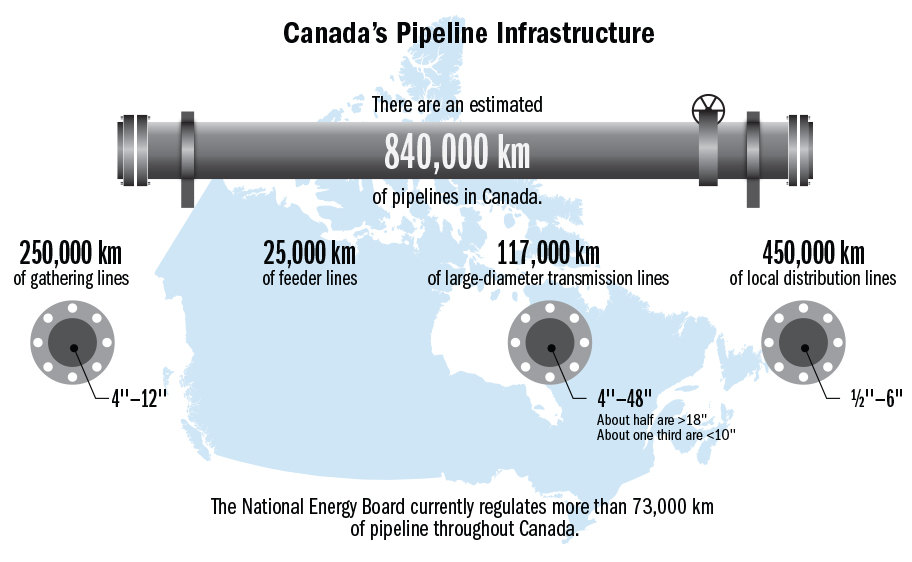Pipelines Across Canada
There are more than 840,000 kilometres (km) of transmission, gathering and distribution pipelines in Canada — including 117,000 km of large-diameter transmission lines — with most provinces having significant pipeline infrastructure. Of this amount, about 73,000 km are federally regulated pipelines, which are primarily transmission pipelines. Pipelines are generally buried underground and operate in both remote and populated areas, with major crude oil and natural gas pipelines servicing most major Canadian cities.
Pipelines are a safe, reliable and environmentally friendly way of transporting oil and gas. Spills, leaks and ruptures are rare, representing a tiny percentage of what is flowing through the pipelines. On average each year, 99.999 percent of the oil transported on federally regulated pipelines moves safely. Only very minor amounts of liquids are spilled and are typically confined to pipeline company property and recovered in cleanup operations.
Generally, pipelines that cross provincial borders are federally regulated, and pipelines that are entirely within one province are regulated by the respective provincial authority where they are located. Provincially regulated lines include the smaller natural gas distribution pipelines that go to every house equipped with a natural gas furnace or water heater. For example, there are more than 450,000 km of these local distribution pipelines in Canada.

Pipelines meet Canadian needs
Pipelines are necessary to deliver fuel for Canadians to heat their homes, drive their cars and travel by bus, ship, train and air. Cars, buses, trains, boats and airplanes are all fuelled by petroleum products such as gasoline, diesel and aviation fuel. Petroleum products are also used as feedstock to make materials found in everyday household items, such as toiletries, electronics and clothes. Pipelines are used to move these petroleum products to refineries and to customers across the country. Canadians simply could not live as they do today without pipelines.
Pipelines benefit Canadians
The oil and gas sector also contributes significantly to the strength of Canada’s economy. This sector directly and indirectly employs about 740,000 people. The oil and gas sector contributes nearly 11 percent of Canada’s GDP and pays on average more than $20 billion per year in taxes, royalties and fees to governments. In 2014, federally regulated pipelines shipped about $159 billion worth of crude oil, petroleum products, natural gas liquids and natural gas to Canadians and export customers at an estimated transportation cost of $7 billion.
Building on the largest global energy relationship
Canada has an enormous endowment of oil and natural gas resources but only one significant export customer: 100 percent of our natural gas exports and 97 percent of our oil exports currently go to the United States. This relationship has served both countries well and will continue to do so in the future. However, Canada will need to find new markets, to ensure our oil and natural gas resources sector remains a source of jobs, prosperity and opportunity. To reach these markets, we will need additional pipeline capacity.
Domestic markets are equally important
Delivering western Canadian crude oil to central and eastern Canada would allow Canadian refineries to process more Canadian oil instead of importing foreign oil. This would improve the refineries’ economic and financial viability and increase markets for Canadian oil producers. Generating Canadian jobs and increasing Canada’s energy prosperity are equally as important to the country’s future as accessing world markets.
Pipelines are stringently regulated
The Canada Energy Regulator (CER, formerly the National Energy Board) regulates pipelines throughout their life cycle – from pipeline design and application, construction and operation through to abandonment. The robust system protects Canada’s rich natural environment, respects the rights of Indigenous peoples, and supports a resilient and sustainable energy sector.
Indigenous peoples are an integral part of the pipeline planning and development process
The government is working to enhance its approach to Indigenous consultation and better integrate Indigenous peoples into the pipeline planning and development process. Efforts to advance this objective include working with industry and key federal and provincial agencies and other partners to enhance Indigenous engagement on project planning, development, monitoring, incident response, and general pipeline and environmental safety.
Public hearings ensure all relevant information is considered
Before a decision is made on an application for a major pipeline project – those with 40 km or more of new pipeline – the CER will hold a public hearing. These hearings give concerned parties, including Indigenous peoples, a chance to provide their views on the application. The government is committed to providing ways for Canadians to express their views and opportunities for experts to meaningfully participate. To determine whether a proposed pipeline project is in the Canadian public interest, the CER thoroughly considers the various environmental, engineering, land, financial, economic and socio-economic matters presented during the hearing. For major pipeline projects, the CER will issue a report with its recommendation to the Government of Canada, who will make the final decision on the project.
Page details
- Date modified: